
Retro Gaming vs Modern Televisions
I've been having a mid-life crisis of late and been re-living my earlier gaming years. This has brought up some interesting problems when it comes to integrating the old hardware with modern equipment that has very much entered the digital age.
This is going to get geeky quite quickly as the discussion of these matters involves knowing a bit of terminology. So before I even begin, I'm going to cover the basics. I expect to lose a few people way before the end of page one.
Analogue video standards

RF (Radio Frequency)
When the first consoles came about the only socket on the back of your TV was for an aerial, known as an RF socket. Being designed to receive broadcast television, this is by far the least ideal way of connecting you console and the worst in quality terms as the video and audio signals are modulated into a radio frequency signal.
On early consoles this was your only choice and thankfully, most TVs still have an analogue tuner in there so you should be able to get it working. However once that's gone you'll have to look to modifying the console to output something else. For example it is possible to modify a Atari 2600 to output Composite Video.

Composite Video
This usually manifests itself as a yellow phono socket. Amazingly a lot of modern TVs still have this very basic method of connection.
It was primarily used in the day for VCRs and video cameras. But early Playstations also had this on the back, also many Nintendos up to, and including the GameCube still support this with a specific cable (usually bundled with the console).
Composite is a big step up from RF, as no modulation is occuring and it combines all the video and sync* information required to recreate a color picture on a single wire.
This is the first time we get separate audio, usually found as two more phono jacks (red-right white-left). Which is common to all the following connection types other than SCART which has audio on pins in the connector.
*In most domestic applications sync is actually called composite sync as it's both horizontal and vertical sync combined. Some pro applications will have two lines to carry these separately. But as nothing I'm going to be covering supports that, it'll just confuse matters, so I'm just calling it sync in this article.
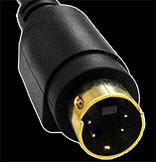
S-Video
Recognisable as a 4 pin mini-DIN style socket, S-Video separated the luma and chroma parts of the video signal. (Luminance is the black and white along with sync, Chrominance is the colour part; hue and saturation).
Most common with video cameras and the few of us that had Laserdisc players. It was the highest quality connection of it's day and is again, a step up from composite.
Some TVs still have this, but given it was quite high end and not as popular as composite, it's starting to disappear (it's gone from mine even though it still has a composite jack on it).
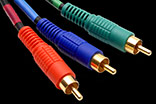
Analogue Component Video
Very popular in the US, component video mostly passed us by in the UK. This consists of 3 phonos usually coloured red, green and blue. Not to be confused with RGB. They split the analogue signal further: Y(green)= Brightness, Pr(red)=luma without red, Pb(blue)=blue without luma. Sync is on the Y channel.
As sources we only really see this in the UK on consoles. The GameCube, PlayStation 2, Xbox and Xbox 360 being the ones I've had that support it. My TV and amplifier still have these but I can see this being phased out before long with the dominance of HDMI now.
This is a very high quality signal and can run much higher resolutions than any of the earlier standards.
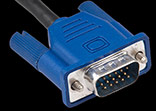
VGA (Video Graphics Array)
VGA, specifically, refers to a computer standard display at 640x480 progressive scan. VGA the connector (15pin D-sub style) can carry other standards (SVGA-800x600, XGA-1024x768, etc), but we're mostly interested in this case in good old VGA.
Being a computer format this is essentially a high quality RGB connection. It is also one connection that can have seperate horizontal and vertical sync (or composite sync on the horizontal line).
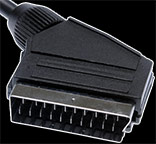
SCART
SCART carries both audio and a variety of video signals from composite, through S-Video, up to RGB. Often seen as the holy grail connection for earlier consoles, it's also the most problematic as it's not very standard at all...
We're most interested in RGB over SCART as this is the highest quality option. RGB splits the signal into it's component colours; Red, Green and Blue (hence the name). Where it all becomes overly complex and annoying, is where it gets it's sync signal from. As there are three different methods.
Sync over composite video is most common. It works, but can suffer from dot crawl and other artifacts. Sync on luma (the Y signal of S-Video) and sync on colour (most commonly sync on green) are less susceptible to this. Sync on colour is least common, but Sony were big proponents of this in both their consoles and TVs.
If you're getting interference, and your TV supports it, you can try and use a different cable utilising a different way of carrying sync. I highly reccomend Retro Gaming Cables who can tailor their cables to your requirements.
Another way of fixing this is using a Sync Stripper. What this does is remove the video signal from the sync pulses to stop it interfering. In effect giving a clean sync + RGB. RetroRGB make a board called a sync in SCART that can go inside of your SCART head that does exactly this.
Professional Monitors
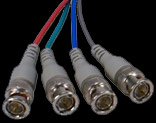
Professional monitors tend to have 4 BNC connectors; RGB and a separate composite sync line. If they have 5 connections it's likely it has 2 sync lines like VGA.
Smashing, that's most people zoned out, and I've only just got started ;) Onwards